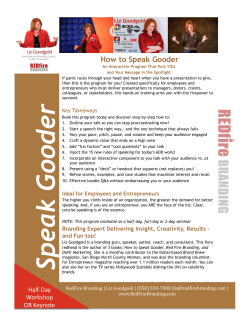
Chapter 8 Strategies for Marketing, Sales, and Promotion 1
Chapter 8 Strategies for Marketing, Sales, and Promotion 1 Creating an Effective Web Presence • Businesses always create a presence in the physical world by building stores and office buildings. • The only contact that customers and other stakeholders have with a firm on the Web is through its presence there. • Creating an effective Web presence can be critical even for the smallest and newest firm operating on the Web. 2 Learning Objectives In this chapter, you will learn about: • Establishing an effective business presence on the Web • Promoting your Web site • Meeting the needs of Web site visitors • Creating trust and building loyalty in Web site visitors • Testing usability in Web site design 3 Learning Objectives (Cont.) • Identifying and reaching customers on the Web • Choosing successful marketing approaches for the Web • Understanding the elements of branding • Considering branding strategies and costs • Choosing a business model for selling on the Web 4 Identifying Web Presence Goals • On the Web, businesses have the luxury of intentionally creating a space that creates a distinctive presence. • A Web site can perform many image-creation tasks very effectively, including: – – – – – Serving as a sale brochure Serving as a product showroom Showing a financial report Posting an employment ad Serving as a customer contact point 5 Achieving Web Presence Goals • An effective site is one that creates an attractive presence that meets the objectives of the business or other organization. • Possible objectives include: – – – – – – – Attracting visitors to the Web site Making the site interesting enough Convincing visitors to follow the site’s links Creating an impression of corporate image Building a trusting relationship with visitors Reinforcing positive images of the organization Encouraging visitors to return to the site. 6 The Toyota Site • The Toyota site is a good example of an effective Web presence. • The site provides: – A product showroom feature – Links to detailed information about each product line – Links to dealers – Links to information about company 7 Quaker Oats • Quaker Oats has created Web sites that did not offer any corporate presence until 1999. • In 1999, Quaker Oats changed its Web page to improve its general appearance and userfriendliness. • The Toyota and Quaker Oats examples illustrate that the Web can integrate an opportunity for enhancing the image of a business with the provision of information. 8 Not-for-Profit Organizations • A key goal for many not-for-profit organizations is information dissemination. • The combination of information dissemination and a two-way contact channel is a key element in any Web site. • The American Civil Liberties Union and American Red Cross have created effective Web presences. • Political parties and museums also use Web site for their image presences. 9 How the Web is Different • The failure to understand how the Web is different from other presence-building media is one reason that businesses fail to achieve their Web objectives. • Firms must use the Web’s capability for two-way, meaningful communication with their customers. 10 Meeting the Needs of Web Site Visitors • Businesses that are successful on the Web realize that every visitor to their Web site is a potential customer. • Creating a Web site that meets the needs of visitors with a wide range of motivations can be challenging. • Technology variation can be another concern to Web presence. 11 Meeting the Needs of Web Site Visitors • A good Web site should give the visitor the option to select smaller versions of the images. • A good site design lets visitors choose among information attributes, such as level of detail, forms of aggregation, viewing format, and downloading format. 12 Trust and Loyalty • When customers buy a product, they are also buying that service element. • A seller can create value in a relationship with a customer by nurturing customers’ trust and developing it into loyalty. • Customer service is a problem for many corporate sites. • A primary weak spot for many sites is the lack of integration between the companies’ call centers and their Web sites. 13 Usability Testing • Firms are now starting to perform usability testing to their Web sites. • As the usability testing becomes more common, more Web sites will meet their goals. • Eastman Kodak, T. Rowe Price, and Maytag have found that a series of Web site test designs help them a lot. 14 Identifying and Reaching Customers • Two general ways of identifying and reaching customers: personal contact and mass media. • An important element of corporate Web presence is connecting with site visitors who are customers or potential customers. • Mass media is a one-to-many communication model, the Web is a Many-to-one communication model, and personal contact is a one-to-one communication model. 15 Measuring the Effectiveness of Web Site Advertising • The pricing metric in mass media is called costper-thousand and is often abbreviated CPM. • Measuring Web audiences is more complicated. • Banner ads are often sold on a CPM basis where the ‘thousand’ is 1000 impressions. • Rates vary greatly and depend on how much demographic information the Web site obtains about its visitors, but most are within the range of $1 to $100 CPM. 16 New Marketing Approaches for the Web • The Web is an intermediate step between mass media and personal contact. • Using the Web to communicate with potential customers offer many advantages of personal contact selling and many of the cost savings of mass media. • GartnerGroup reported that customer-centered marketing strategies would be an excellent fit for the Internet marketplace. 17 Technology-Enabled Relationship Management • Technology-enabled relationship management occurs when a firm obtains detailed information about a customer and uses that information for marketing purpose. • It is also called customer relationship management (CRM) or electronic customer relationship management (eCRM). 18 Creating and Maintaining Brands on the Web • A known and respected brand name can present to potential customers a powerful statement of quality and value. • Branded products are easier to advertise and promote, because each product carries the reputation of the brand name. 19 Elements of Branding • The key elements of a brand are differentiation, relevance, and perceived value. • Product differentiation indicates that the company must clearly distinguish its product from all others in the market. • Relevance is the degree to which the product offers utility to a potential customer. • Perceived value is a key element in creating a brand that has value. 20 Emotional Branding vs. Rational Branding • Companies have traditionally used emotional appeals in their advertising and promotion efforts to establish and maintain brands. • Rational branding relies on the cognitive appeal of the specific help offered, not on a broad emotional appeal. 21 Permission Marketing Strategies • Many businesses may send e-mail messages to their customers and potential customers. • The practice of sending e-mail messages to people who have requested them is a part of marketing strategy called permission marketing. • One Web site that offers opt-in e-mail services is yesmail.com. 22 Brand-Leveraging Strategies • Rational branding is not the only way to build brands on the Web. • One method that is working for wellestablished Web sites is to extend their dominant positions to other products and services. • Yahoo! is an excellent example of this strategy. 23 Affiliate Marketing Strategies • In affiliate marketing, the affiliate firm’s Web site includes descriptions, reviews, ratings, or other information about a product that is linked to another firm’s site that offers the item for sale. • The affiliate site receives a commission. • The affiliate site also obtains the benefit of the selling site’s brand in exchange for the referral. 24 Viral Marketing Strategies • Viral marketing relies on existing customers to tell other persons about the products or services they have enjoyed using. • Viral marketing approaches use individual customers to spread the words. 25 Brand Consolidation Strategies • Another way to leverage the established brands of existing Web sites was devised by Della & James, an online bridal registry. • Della & James offers a single registry that connects to several local and national department and gift stores, including Crate&Barrel, Dillard’s, Gump’s, Neiman Marcus and Williams-Sonoma. 26 Cost of Branding • Transferring existing brands to the Web or using the Web to maintain an existing brand is much easier and less expensive than creating an entirely new brand on the Web. • Promoting the company’s Web presence should be an integral part of brand development and maintenance. • Integrating the URL with the company logo on brochures can also be helpful. 27 Web Site Naming Issues • The legal and marketing aspects of Web site naming can be complicated. • Obtaining identifiable names to use for branded products on the Web is important. • URL brokers sell or auction domain names. • The Internet Corporation for Assigned Names and Numbers (ICANN) maintains a list of accredited domain name registrars. 28 Selling Goods and Services • The business model of selling goods and services on the Web is based on the mail order catalog business model. • When the catalog model is expanded to the Web site, it is called the Web-catalog model. • Compaq, Dell, and Gateway are examples of selling computers on the Web. 29 Selling Information or Other Digital Content • Firms that own intellectual property have embraced the Web as a new and highly efficient distribution mechanism. • ProQuest is a Web site that sells digital copies of published documents. • The ACM Digital Library offers subscriptions to electronic versions of its journals to its members and to libraries. • Encyclopedia Britannica is an example that has transferred an existing brand to the Web. 30 Advertising-Supported Model • The advertising-supported business model is the one used by network television in the U.S. • The success of Web advertising has been hampered by two major problems: – No consensus has emerged on how to measure and charge for site visitor views – Very few Web site have sufficient numbers of visitors to interest large advertiser. 31 Advertising-Subscription Mixed Model • In this mixed model, subscribers pay a fee and accept some level of advertising. • The New York Times and The Wall Street Journal use a mixed advertisingsubscription model. • The Reuters wire service also uses a mixed model in its Web offerings. 32 Fee-for-Transaction Models • The travel agency business model involves receiving a fee for facilitating a transaction. • Now, a number of online travel agencies began doing business on the Web. • Stock brokerage firms use a fee-fortransaction model. They charge their customers a commission for each trade executed. 33
© Copyright 2025




















